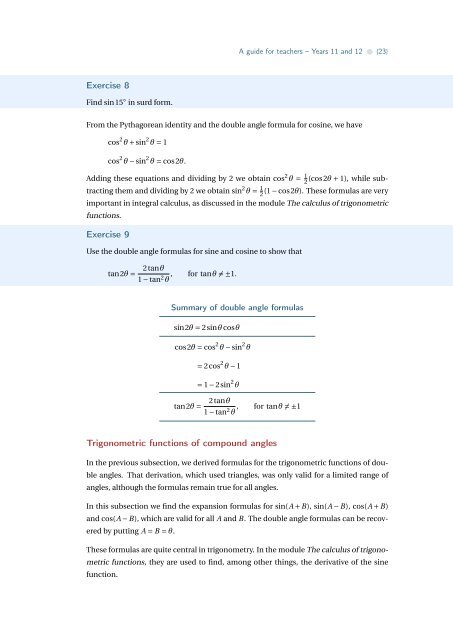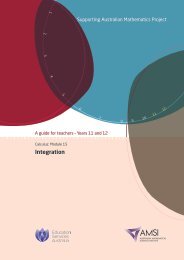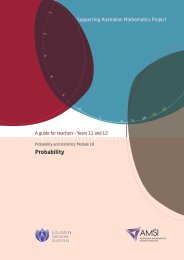Trigonometric functions and circular measure - the Australian ...
Trigonometric functions and circular measure - the Australian ...
Trigonometric functions and circular measure - the Australian ...
- No tags were found...
Create successful ePaper yourself
Turn your PDF publications into a flip-book with our unique Google optimized e-Paper software.
A guide for teachers – Years 11 <strong>and</strong> 12 • {23}Exercise 8Find sin15 ◦ in surd form.From <strong>the</strong> Pythagorean identity <strong>and</strong> <strong>the</strong> double angle formula for cosine, we havecos 2 θ + sin 2 θ = 1cos 2 θ − sin 2 θ = cos2θ.Adding <strong>the</strong>se equations <strong>and</strong> dividing by 2 we obtain cos 2 θ = 1 2(cos2θ + 1), while subtracting<strong>the</strong>m <strong>and</strong> dividing by 2 we obtain sin 2 θ = 1 2(1 − cos2θ). These formulas are veryimportant in integral calculus, as discussed in <strong>the</strong> module The calculus of trigonometric<strong>functions</strong>.Exercise 9Use <strong>the</strong> double angle formulas for sine <strong>and</strong> cosine to show thattan2θ =2tanθ1 − tan 2 , for tanθ ≠ ±1.θSummary of double angle formulassin2θ = 2sinθ cosθcos2θ = cos 2 θ − sin 2 θ= 2cos 2 θ − 1= 1 − 2sin 2 θtan2θ =2tanθ1 − tan 2 , for tanθ ≠ ±1θ<strong>Trigonometric</strong> <strong>functions</strong> of compound anglesIn <strong>the</strong> previous subsection, we derived formulas for <strong>the</strong> trigonometric <strong>functions</strong> of doubleangles. That derivation, which used triangles, was only valid for a limited range ofangles, although <strong>the</strong> formulas remain true for all angles.In this subsection we find <strong>the</strong> expansion formulas for sin(A + B), sin(A − B), cos(A + B)<strong>and</strong> cos(A − B), which are valid for all A <strong>and</strong> B. The double angle formulas can be recoveredby putting A = B = θ.These formulas are quite central in trigonometry. In <strong>the</strong> module The calculus of trigonometric<strong>functions</strong>, <strong>the</strong>y are used to find, among o<strong>the</strong>r things, <strong>the</strong> derivative of <strong>the</strong> sinefunction.
















